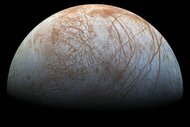Create a free profile to get unlimited access to exclusive videos, sweepstakes, and more!
Distant solar system object 2014 UZ224 is not terribly big but at least it's really really cold

[Artist's conception of 2014 UZ224. Credit: Alexandra Angelich (NRAO/AUI/NSF)]
Using an array of radio telescopes, astronomers have taken the temperature of one of the most distant known members of the solar system. Called 2014 UZ224 [some people refer to it as “DeeDee,” for “Distant Dwarf (planet)”], it’s a balmy 30° C above absolute zero (-406° F). But don’t worry about packing your coat; it’s currently 14 billion kilometers from Earth, so it’s not going to be a vacation spot for some time yet.
First, a little background. Deep background.
Our solar system does not end beyond Neptune (or Pluto, if you want). Out past the major planets the solar system still goes on, even if the objects that reside there are smaller. We divide this vast volume of space into three more-or-less overlapping regions: The Kuiper-Edgeworth Belt, which goes from Neptune’s orbit out to roughly 7.5 billion kilometers from the Sun; the scattered disk, which just overlaps the outer edge of the KEB and goes out to 150 billion km; and the Oort Cloud, which starts 300 billion km out, and goes on for several trillion km.
I explain all this in my episode of Crash Course Astronomy on the outer solar system:
Our new friend, UZ224, is part of the scattered disk, the middle region. It has a decently elliptical orbit that takes it as close to the Sun as 5.7 billion km — about the same distance as Pluto — but stretches out to the bone-chilling distance of 27 billion km. Right now it’s nearing perihelion (closest approach to the Sun), reaching that point in the year 2142. Its year is 1136 Earth years long, so from its point of view, it’s practically diving into the Sun right now.
UZ224 was discovered in the Dark Energy Survey, a project using a 4-meter telescope to observe 5000 square degrees of the sky, about an eighth of the entire sky. The primary purpose is to look for very distant supernovae, to help measure how rapidly the universal expansion is accelerating (yeah, you’ll want to watch this episode of Crash Course Astronomy to find out more about that), but a nice side benefit is that it can also find very distant objects in the solar system. As they move slowly from night to night, software can pick them out compared to the fixed stars.
UZ224 was found in images taken between September and October 2014. It’s faint; the faintest star you can see with your naked eye is about six million times brighter. The orbit was calculated, and as of now there is only one other object farther out for which the orbit has been determined (Eris, the object that kicked off the whole “is Pluto a planet?” debate; another object, V774104, is even farther out but an orbit for it has not yet been published).
So, how big is it? Well, that’s a problem. Using optical and near-infrared observations, it’s hard to say. We see these objects by reflected sunlight, and a big but dark object will appear just as bright as a smaller, but shinier, one. We can get around that, though, by looking farther out in the spectrum. Any object above absolute zero emits energy in the form of light, and something this far out from the Sun should be emitting faint but detectable radio waves. Using the Atacama Large Millimeter/submillimeter Array (ALMA), they easily saw UZ224, and were able to determine, given its brightness, that it’s 635 kilometers across. That’s not terribly big —the Earth is 20 times wider, and even dinky Pluto is four times as big. It’s actually kindof amazing we can see it at all at such a huge distance, really!
Interestingly, they can use that information to calculate how reflective UZ224 is, and it has an albedo of 0.13, which means it reflects about 13% of the light that hits it. This surprised me! Many objects out that far are much more reflective. Pluto has an albedo of 0.72, and Eris 0.96. This object is darker, implying its surface is a mix of ice and rock. Many such objects appear red (like much of Pluto and its moon Charon’s surface) due to sunlight breaking down molecules like methane and rebuilding them into more complex organic molecules called tholins that tend to be reddish or brown. The observations indicate it does have a red hue.
Incidentally, given its size and likely composition, its gravity should be strong enough to shape it into a sphere, too. We won’t know that for sure for a long time, though. It’s so small and so far away that it only looks like a dot in even our most powerful telescopes.
But these new observations are still very important. We only know of a couple of hundred scattered disk objects right now, and so each one we discover and categorize is needed.
Remember, too: It’s been theorized that there’s another planet-sized object out there past Neptune, tentatively called Planet Nine (not to be confused with Nibiru, which we know doesn’t exist; please send your hate mail to nope@nope.planetnine), and its existence has been inferred due to the orbital alignment of a handful of scattered disk objects. So there are still some pretty big mysteries out there in that part of the solar system. The only way to solve them? Keep exploring.




























